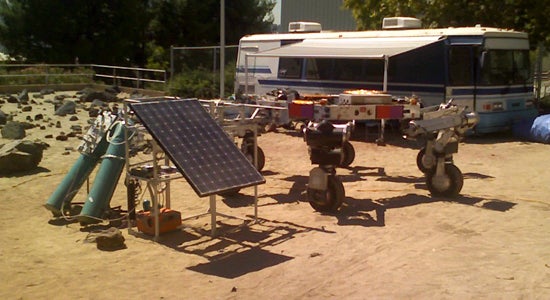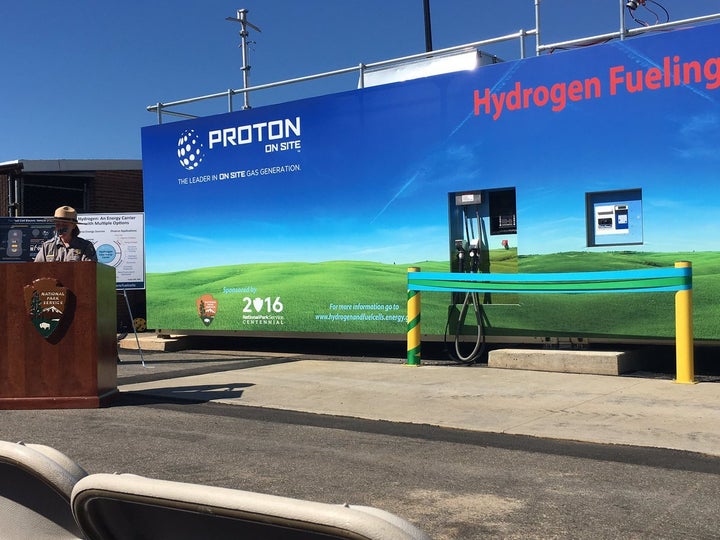
NASA plans to use hydrogen fuel cells to propel its planetary surface vehicles and batteries to spin drill bits in its power hand tools for future manned landing missions, including the 2035 trip to Mars.
Simple physics, and the electrochemical attributes endemic to these two power systems, have made NASA’s choices relatively simple:
Fuel cell electric vehicles (FCEVs) offer longer ranges and provide more power in smaller, lighter packages than battery electric vehicles (BEVs).
“Fuel cells tend to be more optimum for higher-power, longer duration applications,” said Mark Hoberecht, principal investigator for fuel cell systems at NASA’s Glenn Research Center in Cleveland. “They are also lighter in weight for the amount of energy you get, than what the battery electrodes are.”
Batteries must be made bulkier to enable vehicles to go farther. So over longer ranges, they become “less efficient, because you’re hauling around all that weight,” Hoberecht explained.
NASA expects to use batteries for “lower-power, shorter duration” tasks like rotating bits in handheld drills.
Fuel cells are also set to power the lunar and planetary bases where the astronauts will live and work.
Specifically, regenerative hydrogen fuel cells - those with solar-powered electrolyzers that split water into hydrogen and oxygen - look to form the core of a closed-loop, zero emissions, planetary energy system, which will provide electricity and sustain life on celestial bases.
The process would begin once a lander touches down on say, Mars, for instance. Solar arrays will unfurl and power an electrolyzer that begins to separate water into hydrogen - the fuel that fuel cells use to produce electricity - and oxygen. The fuel cells will then use the hydrogen to make electricity. Water and heat, the byproducts of fuel cell electricity production, are then recycled through the system, enabling continuous energy production and usage.
The sun provides power during the daytime that the electrolyzer uses to produce hydrogen, which is stored, and then used by fuel cells to produce electricity that sustains habitats and powers rovers.
The regenerative fuel cells are able to store more energy in a lighter payload than advanced batteries can.

Sourcing Water to Produce Hydrogen
Historically, NASA has produced astronauts’ drinking water in-flight, by running fuel cells that provide electricity to its spacecraft. This has enabled crews to drink water as the fuel cells produced it, thereby lightening overall payloads.
“One of the main reasons that fuel cells were selected as the power source for the [Space] Shuttle was because it was a weight-saving consideration,” Hoberecht said. “That continues to apply to all future space missions: If they’re manned missions, then fuel cells are part of the trade study.”
Once on Mars, water is expected to be harvested by the astronauts. Plans call for baking or microwaving martian ice extracted from the red planet’s rocks, soil or north pole ice cap. Water may also be gleaned from submerging martian rocks containing hydrogen in a hot, highly pressurized “supercritical” carbon dioxide fluid. Doing so can free up formerly encased hydrogen to combine with oxygen to form water.
If on Mars, Why not Earth, Where all the Humans Are?
The clean energy promise of regenerative fuel cells has inspired various earthbound commercialization efforts aimed at zero-emissions car driving and electricity storage.
The solutions package an electrolyzer and a hydrogen refueling station into a single unit, which can be solar- or wind-powered.
Waltham, Mass.-based Ivys Energy Solutions, the North American arm of France’s McPhy Energy, and Warminster, Penn.-based PDC Machines are in the process of validating an appliance they’ve collaborated on called SimpleFuel, which fuel cell car owners could install in their homes to refuel vehicles.

The Department of Energy and Wallingford, Conn.-based Proton OnSite unveiled last month a hydrogen station in Washington that will refuel a federal fleet of fuel cell vehicles to act as a hub for DOE analysis and a showcase to lawmakers. The solution integrates a high-pressure electrolyzer from Proton OnSite, and compression, storage and dispensing components from Allentown, Penn.-based Air Products & Chemicals, into a single, 12-meter long unit, which is small enough to ship on the back of a flatbed truck.
The station is “compact and site-ready,” says Steve Szymanski, director of business development at Proton OnSite.
This “containerized approach” is a way for regenerative hydrogen fueling stations to more quickly “go through permitting” and get up and running, says Sunita Satyapal, director of the DOE’s fuel cell technologies office.

Fuel Cell 101
Fuel cells work by taking advantage of the fact that hydrogen (H2) and oxygen (O2) are naturally attracted to each other, the end result being water. In a fuel cell, a barrier is placed in between H2 and O2, and a “catalyst” is placed in front of H2, which splits the H2 into H+ (protons) and e- (electrons). The H+ protons can get through the barrier, often a proton exchange membrane (PEM), but the negative electrons, the e-, cannot. But a wire enables a path for the negative electrons that travels around the PEM barrier to the O2 side. The movement of the negative electrons through the wire is electricity. Once those electrons and protons reach the other side of the barrier they form H2, which then combines with the O2 to create water - a fuel cell’s only emission. Many layers of this simple, single-unit example are packaged together into boxes called “stacks.”
While both fuel cells and batteries are electrochemical devices, a fuel cell is different, essentially, because it requires a continuous fuel source (hydrogen), but never gets or needs “recharging,” and it will operate continuously and at the same rate of power production as long as there is that fuel (hydrogen), no matter the amount remaining, in the tank. Whereas batteries lose their charge and get weaker power production as they lose juice, and degrade over time as they course through charging and discharging cycles.
